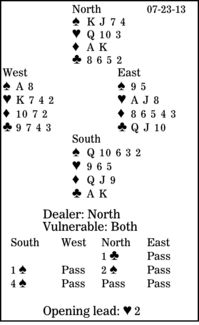Bridge column, July 23: Read the lead to help defend

A bridge player should live with the "trade" acronym in his mind, whether as declarer or a defender. The second letter stands for read the lead. Third hand should use the information being supplied by the opening lead to guide his defense -- as in this example deal.
South is in four spades. West leads the heart two. What should East do after declarer calls for dummy's three?
Note that South's jump to four spades almost guarantees at least a five-card suit. Since North can raise to two spades with only three-card support when he has a singleton somewhere, if South has only four spades and sufficient strength at least to try for game, he should rebid in no-trump or another suit. If North has four spades, he will commit to that suit. (Well, if he is exactly 4-3-3-3 with four weak spades, he might pass out three no-trump.)
There seem to be two ways to try to gain four defensive tricks: one heart and three clubs, hoping declarer has king-third of clubs and West ace-third; or three hearts and one black-suit trick. First, though, what was West's lead?
His lowest heart, and when a defender leads an unbid suit (at any trick), low from length guarantees at least one honor in that suit. And given the board, what honor must West hold?
Right -- the king. So East should play his jack, expecting to win the trick, cash his heart ace, and play a third heart. Later, West's spade ace will defeat the contract.
** ** **
COPYRIGHT: 2013, UNITED FEATURE SYNDICATE
DISTRIBUTED BY UNIVERSAL UCLICK FOR UFS

